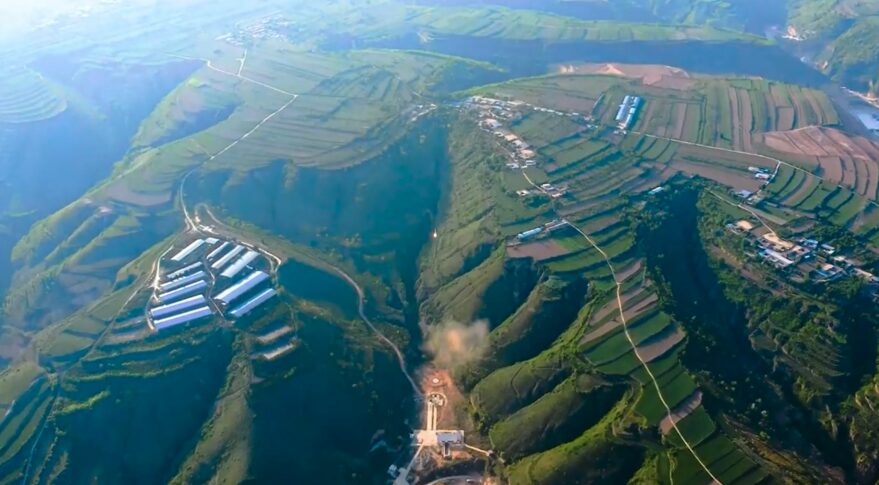
Deep Blue Aerospace completes kilometer-level rocket launch and landing test (Image Credit: Space News)
HELSINKI — A Chinese launch startup sent a small rocket test stage up to an altitude of one kilometer Friday before a performing a powered descent and vertical landing.
Deep Blue Aerospace, founded in 2017, conducted the test May 6 with the Nebula M1 test article at a facility at Tongchuan, Shaanxi Province, landing within less than half a meter of the landing pad “bullseye”.
The test is a milestone in the development of the full Nebula-1 rocket with a recoverable first stage, and indicative of progress and efforts by Chinese launch startups to develop reusable launchers.
The Nebula M1 is powered by a variable thrust Leiting-5 (“Thunder-5”) electric-pump-fed kerosene-liquid oxygen engine. The landing in the video is obscured by dust thrown up by the thrust, but the company claims the test was successful.
Deep Blue Aerospace yesterday conducted a one kilometre level launch and landing VTVL test with its Nebula-M test article, as part of development of the Nebula-1 reusable orbital launcher. https://t.co/BaDs7Xyuez pic.twitter.com/lTDN6MZ5tD
— Andrew Jones (@AJ_FI) May 7, 2022
The Nebula-M was used in two earlier, successful tests to altitudes of around 10 and 100 meters. New tests—to altitudes of 10 and 100 kilometers—will be conducted using a new test stage on the same scale as the full scale Nebula-1 rocket. It will use more powerful 20-ton-thrust Leiting-20 engines, which are to undergo testing as a next step.
The first orbital launch and recovery of the Nebula-1 is planned for before the end of 2024.
Huo Liang, founder of Deep Blue Aerospace, told SpaceNews in an earlier interview that the firm is targeting both private launch contracts and government programs including the national satellite Internet project and the space station as possible revenue streams.
The company received a boost last month, announcing undisclosed A+ round financing April 19, three months after it raised $31.5 million in A round funding. Last autumn Deep Blue Aerospace employed nearly 100 people, with some coming from China’s traditional space industry institutes and companies, and some from areas such as the automobile and aviation industries. Around 70 percent of the team are engineers.
Deep Blue Aerospace claims the vertical takeoff, vertical landing (VTVL) reached the highest altitude for such a test conducted in China, while also reaching the greatest speed and longest flight time.
The apparent previous altitude record was of 300.2 meters set by Linkspace in 2019 using its RLV-T5 vehicle. After an apparent hiatus, Linkspace is now targeting a 100-kilometer level test in Q4 this year after a recent successful static fire test of the larger, methane-liquid oxygen RLV-T6.
Deep Blue Aerospace and Linkspace are not the only commercial Chinese launch firms working towards reusability. Beijing-based iSpace is developing the methalox Hyperbola-2 launcher while Galactic Energy (Pallas-1), Space Pioneer and others are also developing liquid propellant launchers and vertical takeoff, vertical landing capabilities.
Landspace, one of the early movers in China, recently released images of its Zhuque-2, suggesting its first test launch is near. While the launch will be expendable, the firm plans to convert the methalox rocket into a reusable launcher.
Landspace releases images of the Zhuque-2, suggesting its first test flight from Jiuquan is due soon. A big development: China’s first private liquid rocket & could be the first methane-liquid oxygen launcher into orbit. https://t.co/8cC1yXKe2k pic.twitter.com/cAkpdyw0cW
— Andrew Jones (@AJ_FI) May 3, 2022
The country’s main space contractor, the China Aerospace Science and Technology Corp. (CASC), is also exploring reusability with its Long March 8 derived from existing Long March rockets, while a reusable variant based on the Long March 6 is being developed by CASC’s Shanghai Academy of Spaceflight Technology.
CASC is also developing a new, reusable launcher with three cores for human spaceflight, while its Long March 9 super heavy-lift rocket could also be made reusable.








